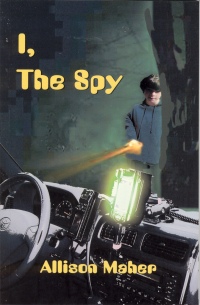| ________________
CM . . .
. Volume XIII Number 2 . . . .September 15, 2006
excerpt:
When 15 year-old Andrew befriends the ‘new’ student, Brian, both of them end up confiding their family secrets: Andrew’s mom tests new spy gadgets for “the good guys,” and Brian’s father, Mr. Fiske, helped the FBI catch mobster money counterfeiters. The FBI’s Witness Protection Program moved Brian’s family from Chicago to Andrew’s home town in Nova Scotia. Andrew’s mother and father, who were present when Brian told his family’s true story, arrange a get-together for the two families in an attempt to assure Brian’s parents that they are in no danger even though their son ‘spilled the beans.’ Andrew’s mom invites Don Proctor, a NAIPA (North American Integrated Policing Agency) agent whom the Fiske family already know and trust to this meeting. Andrew, however, instinctively distrusts the sneaky, spandex-clad Agent Proctor. Over the next few months, Andrew and Brian become inseparable friends. Andrew’s mom lets them play around with some of her electronic “spy gear.” One day, Brian tells Andrew that he’s afraid his house is being watched. The boys make a plan to see if Brian’s suspicions are legitimate. Andrew stuffs Brian’s knapsack with a number of gadgets, including a motion detector, a voice transmitter, and a tracking transmitter for a car. However, before Brian can carry out the plan, he and his family are kidnaped and their house is burned down. Luckily, Brian has the presence of mind to take his knapsack when he’s kidnaped. Andrew doesn’t believe that his friend is dead, despite the fire. Eventually, with help from his parents and thanks to Brian’s bravery, resourcefulness, and bag of gadgets, the mobsters are thwarted before they can deliver Brian’s family to “the boss” in Chicago. And NAIPA’s Agent Proctor is found guilty of betraying Brian’s family. Allison Maher’s first juvenile novel gets off to a strong start with a likeable – if not entirely credible – narrator making interesting observations about his home-town, his parents, and the ‘new’ kid, Brian. The author previously worked for a company that invented “spy gear,” and some young readers will enjoy the relatively detailed descriptions of a number of electronic gadgets. The story also includes some interesting trivia, including, for instance, why people without a compass or a path to follow don’t walk in a straight line: Most people’s right leg is longer and stronger than their left, a situation which means their left leg will make shorter strides than their right. If one side of your body is going faster and further than the other, you will automatically walk in a circle. The fact that the narration changes to the third person for some chapters should not be a problem for readers. For instance, chapter three – a flash-back to Brian’s dad helping the FBI – is told from the perspective of Mr. Fiske. The second half of I, The Spy is fast-paced with some surprises and suspenseful moments. However, given the circumstances, the reader feels very little tension. This may be because too many of the characters lack the emotion necessary to really engage the reader. For instance, as Andrew waits and watches for the mobsters’ van – with Brian and his family in it – to drive into a police trap, this is how he describes his feelings:
In another instance, Andrew has just found the kidnappers’ empty van parked in front of an impassable gully. Andrew knows that this means the kidnappers are heading through a forest on foot with Brian. For all he knows, they may have already killed Brian just so that they could move faster. But, incredibly, Andrew doesn’t think about this:
Despite a good start and some interesting detail, this reader ultimately found the story’s characters too shallow to be entirely convincing. Recommended. Karen Rankin is a Toronto writer and editor of children’s stories.
To comment
on this title or this review, send mail to cm@umanitoba.ca.
Copyright © the Manitoba Library Association. Reproduction for personal
use is permitted only if this copyright notice is maintained. Any
other reproduction is prohibited without permission.
NEXT REVIEW |
TABLE OF CONTENTS FOR THIS ISSUE
- September 15, 2006.
AUTHORS |
TITLES |
MEDIA REVIEWS |
PROFILES |
BACK ISSUES |
SEARCH |
CMARCHIVE |
HOME |
